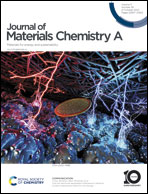The acceleration of BODIPY dye-sensitized photocatalytic hydrogen production in aqueous ascorbic acid solutions using alkyl-chain formed second coordination sphere effects†
Abstract
BODIPY (boron-dipyrromethene) compounds are extensively utilized in various applications. Typically, their activity is modified by altering the functional groups at the α-, β-, and meso-positions of the substituents. However, no systematic information has been provided regarding the effects of substituted F- positions and hydrophobicity on the activity of BODIPY sensitizers in photosensitizing chemistry. Dyes (7a–7c) with different alkyl chain lengths were synthesized and compared with the unsubstituted compound 3 to discuss the effects of –F position substituents and the hydrophobicity of BODIPY dyes on photocatalytic activity. Density functional theory (DFT) calculations showed that –F-substitution induced an intramolecular charge transfer (ICT) effect, enhancing visible-light absorption. Longer alkyl chains provided a favourable second coordination sphere reaction environment for hydrogen production. Experimentally, dye 7c demonstrated the highest activity, with a hydrogen production rate of 496.5 μmol gcat−1 h−1, which is 3 times higher than that of 3, and a 9.6 times higher turnover frequency (TOF) than that of 3. The apparent quantum yield (AQY) at 650 nm was 1.4%. This study highlights the importance of –F position substitution and optimizing hydrophobicity to enhance the photocatalytic activity of metal-free organic dyes through the creation of a new second coordination sphere.



 Please wait while we load your content...
Please wait while we load your content...